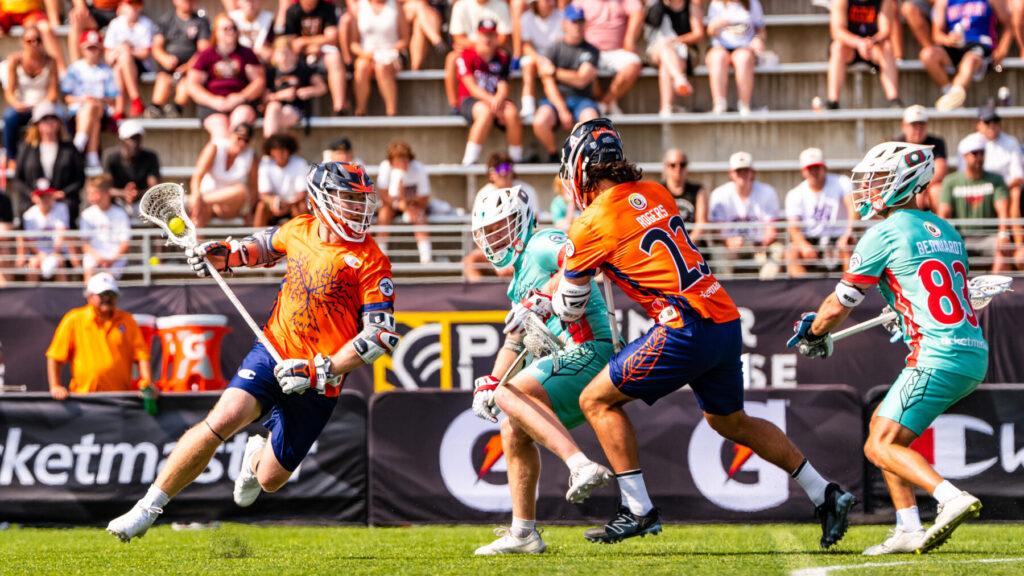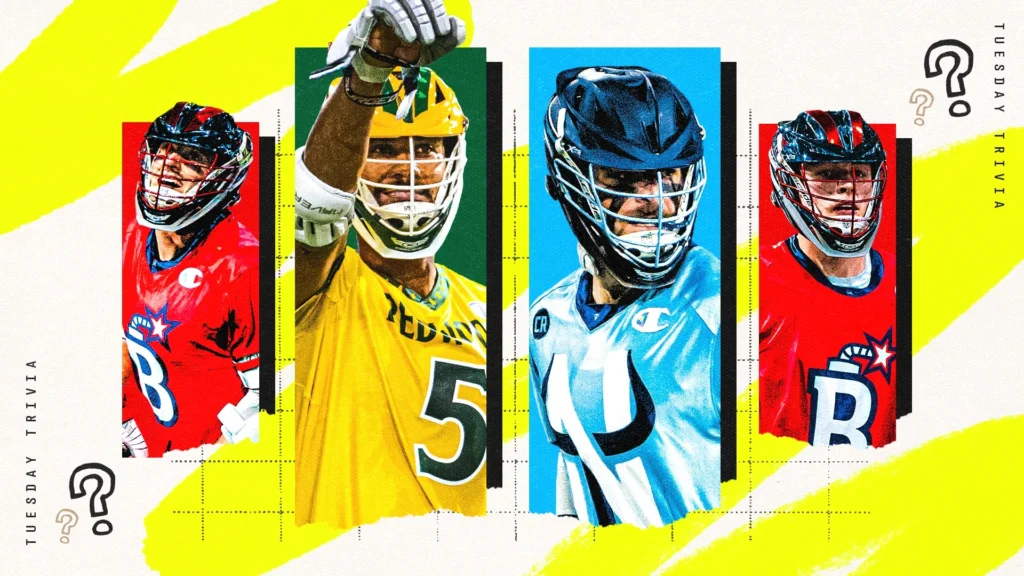
How the Archers Are Thriving With the 32-Second Shot Clock
By Zach Carey
Jul 12, 2023
Through the first four weeks of the PLL season, the new 32-second shot clock after faceoffs has turned up the books. Faceoffs have a lesser value as clubs struggle to generate the same quality of offense in 32 seconds that they do in 52 seconds.
Yet, while teams such as Chrome (1-3) and Atlas (1-3) fail to capitalize on the dominance of their faceoff specialists, the Archers (3-1), who sit atop the league standings, are leading the PLL with a 30.9% efficiency on 32-second possessions.
The Archers have 30 goals on their league-leading 97 32-second possessions, which is 10 more scores than Atlas in second place and 19 more than the Whipsnakes in second. Their 30.9% efficiency is 7.5% better than the 23.4% league average and is even better than five clubs’ (including their own) 52-second efficiency. On Sunday, they scored on 7/23 of those possessions en route to a 15-12 victory over the Whipsnakes.
So, what’s worked so well?
The answer to that question is complex. There’s plenty that goes into efficient offense in short clock situations and the Archers have blended the perfect combination of personnel and strategy to leave the rest of the league in the dust.
Mike Sisselberger is winning faceoffs and winning them cleanly
To generate a volume of 32-second possessions, of course, the club has to win faceoffs. If the Archers’ 3-1 start to the 2023 season has proven anything it’s that Mike Sisselberger was unquestionably the correct pick for the club at no. 5 overall in this year’s College Draft. Sisselberger is second in the league in win percentage at 70.5%, joining Trevor Baptiste (78%) as the only two guys above 70%. He’s been the club’s missing piece.
The Lehigh product has dominated against inferior opposition, winning 85% of his draws this past weekend, 80% in his career debut, and 63% versus Chaos before the break. He also held his own against Connor Farrell (67.4% on the season) by winning 48% of the faceoffs in that matchup.
Sisselberger has been similarly successful beyond the domination at the stripe. The biggest (relative) knock on his game coming out of college was that he could struggle to maintain possession once he won it and that he wouldn’t be able to add anything offensively, both things that have become more important with the 32-second clock after draws.
Any real concern on that front has gone out the window. Sisselberger has only turned the ball over four times in four games, he’s leading faceoff specialists in points with three, and he’s won 84.8% of the draws where he won the clamp, indicating that teams haven’t been able to counter him with any meaningful success so far.
The ease with which he’s won possession has been critical for the Archers offense. By winning the clamp on 69.5% of his attempted faceoffs, winning the possession on 84.8% of those draws, and picking up 44 ground balls, he’s ensuring that the Archers offense gets the ball at a high volume. And because he’s consistently won the ball to himself and turned up field immediately, Sisselberger repeatedly produces possessions where as little time as possible has bled off the shot clock.
The way Sisselberger managed to avoid trouble against the Whipsnakes when Jim Stagnitta’s club started to pester him was especially impressive. On the play below, he manages to win the ball forward despite the Whips using LSM Colin Squires to try to force him backwards. Once he secures the ball, he avoids the pressure from Squires long enough for the Archers to substitute, and then Sisselberger finds the offensive midfielder coming out of the box.
Earlier in the game, Squires did force Sisselberger to win the ball backwards. Again though, Sisselberger deals with the on-ball pressure, confidently clears the ball up-field utilizing his combination of strength and speed, and patiently waits for the attack to work themselves open.
On this pair of possessions, Sisselberger got the ball to the offense with 24 and 20 seconds remaining on the shot clock. That might not be a ton of time, but every second matters in these scenarios.
“‘Siss’ is a bowling ball,” said Archers Head Coach Chris Bates after the win. “He can handle pressure. He handled the Whipsnakes’ poles and I thought did a really good job protecting the ball and then getting rid of it. Ideally you don’t want to go all the way back to the goalie and eat up that clock. If we can avoid it and Siss did what he did today and can get it out – or at least protect it and run and not have to go back [to the goalie] – it keeps us in a flow and gets us into a little bit of a rhythm.”
Matt Moore added that, to be successful with the short clock, “it’s getting the ball down to the attack and just going.”
“I think we just need to [continue] to play at a higher speed because there’s not much time on the clock and you don’t want to waste that possession,” he added. “The importance is winning it forward and getting it to our attack.”
No team so far has challenged Sisselberger to win the ball back all game long. Chaos did well hounding him after the faceoff, but he still managed to provide the offense with a volume of decent chances in that game.
Tracking how Sisselberger fares versus Waterdogs or Cannons, two teams who’ve recently been willing to concede the clamp and have focused on winning the ball afterwards or draining enough clock to make the possession less valuable, will be important moving forward. But, for now, everything has gone smoothly for the Archers in terms of winning the ball and possessing it with enough time on the clock.
The Archers rely on their personnel to attack matchups immediately
Once the possession is won and the transition to the offense begins, the Archers have been generally good at getting their offensive personnel on the field quickly. It would probably be worth experimenting with using more offensively-inclined midfielders on the wings, especially when Sisselberger is dominating.
That aside, though, the Archers have done well to push for immediate initiation via dodge once the offense has the ball. After a Petey LaSalla faceoff violation in the first quarter, the offensive midfielders subbed in nearly immediately and Ryan Ambler carried the ball behind the goal.
With 25 seconds left the offense was already getting into its set, and Ambler set a nifty back screen on Moore’s defender Bryce Young, forcing him to go under and allowing Moore to get a head of steam running up field. With Moore’s size, strength, and ability to shoot through contact, this was as good as a goal from the moment Young decided to go under the screen.
Moore’s presence on attack in Sunday’s win and against Chaos in the third game of the season has been valuable for the Archers in their 32-second offense. He has three goals on 32 second possessions in the last two games, and his willingness to attack the cage and be physical with his matchups has been a boon for the club when they need to generate shots quickly.
“We told Matt a couple days ago that we’re going to ride with him down there for most if not all the game,” commented Bates after the game. Chuckling, he added that “the text back had three exclamation points because he was excited about it.”
“He’s a gamer,” Bates continued. “He doesn’t back down from anybody. We stumbled a little bit early and his goals gave us confidence and got us into a rhythm on his shoulders. That was a key for us.”
Whipsnakes Head Coach Jim Stagnitta was by no means surprised by Moore’s success, but he highlighted that “more than anything else, he was able to shoot the ball with pressure on him and he shot the ball very well.”
Grant Ament’s return to the lineup is seemingly expected in the coming weeks. But, when he does, Moore may have done enough over recent weeks to push for runs at attack. He allows the Archers to initiate offense quicker because of his dodging ability, how he embraces contact, and how he can score without blowing by his defender.
Using offensive sets that efficiently produce good looks
Another key element of what makes for good 32-second offense is schemes that create quick looks at the cage. Like how the Archers set up the Moore goal above, the club has done well to dodge to score early in possessions to ensure that they get the most juice out of every possessional squeeze.
Take this Ryan Aughavin fourth quarter goal as an example. The Archers run their patented “Jackie” offensive set with a two-man game for Aughavin up top and then four players along the goal line to maintain proper spacing. The pick from Challen Rogers gives Aughavin an initial step and the rest of the offense staying low means that he can change direction four times before stepping into a beauty of a shot.
After the game, Bates pointed to how “our spacing was better,” and the impact that had on their 32-second offense. “We had a little better shape, we could either attack from below or up top,” he said. “Our guys did a good job of getting into correct spacing and that just opens things up and puts pressure [on the defense].”
Connor Fields benefitted from the club’s offensive spacing as well. On another 32-second possession, Fields initiated a wing two-man game with fellow lefty Mac O’Keefe. On the other side, their three teammates stayed outside the back pipe, cutting around one another to occupy the potential slide defenders. And, for the cherry on the cake, the Archers hedged on substituting their sixth offensive player on the field, occupying a defender while also ensuring they could’ve substituted immediately.
Fields attacked topside and, because O’Keefe provided surplus space by fading to goal line extended, he was able to split back underneath and score with his off-hand.
“It’s easy to be comfortable in this offense,” said Moore about how the club caters to each player’s strengths. “Everyone is open to everyone else’s playing style. Fieldsy, just giving him space, cutting off ball. He needs that to do his thing.”
By maintaining spacing, using offensive actions that produce quick shots, and putting the ball in the sticks of players who can produce those opportunities at a high level, the Archers are thriving in 32-second offense. And they’re committed to continuing to fight for faceoff wins and for the initial possession after the draw.
"After all the talk about the faceoffs and the lack of importance, I'll take that game all day, everyday,” noted Bates after Sisselberger’s 85% performance and the team’s 7/23 success on the ensuing possessions. “Even if it’s 18 seconds and you force the defense to play and make a stop, that stuff adds up,” he said. ”You got to make a stop.”
While other teams around the league forfeit the draw and others flounder to hit even a 25% success rate on the 32-second possessions their elite faceoff specialists produce, the Archers have capitalized on a deadly combo of an elite specialist, offensive personnel who can score goals quickly, and offensive scheming that provides them the canvas to go to work.
Now it’s up to the rest of the league to catch up.






